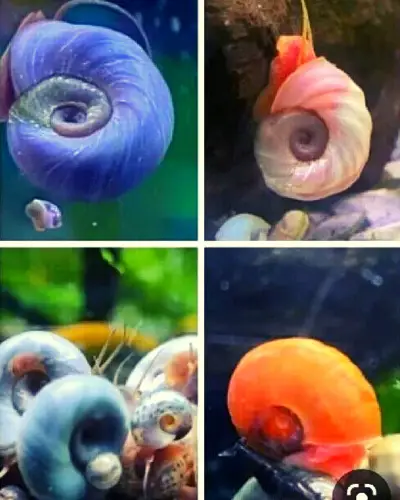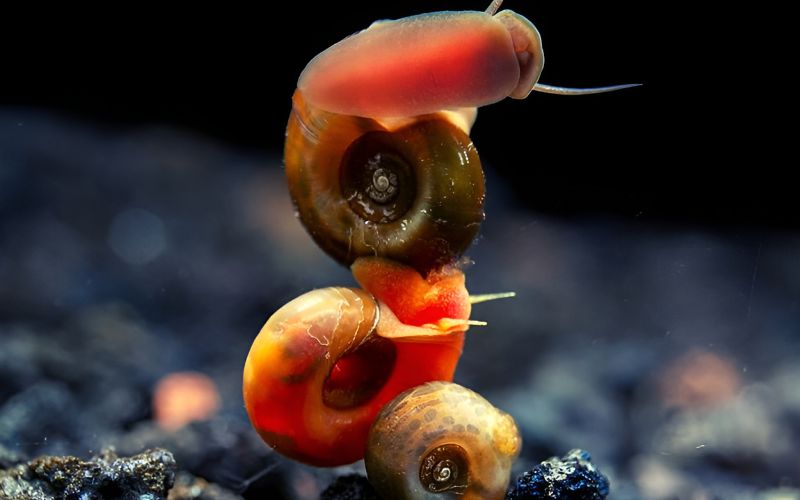Do Ramshorn Snail Colors Breed True? Have you ever wondered why ramshorn snails come in such a fascinating range of colors? From vibrant reds to deep blues and striking leopard patterns, these freshwater snails boast an incredible diversity. Their stunning hues make them a favorite among aquarium enthusiasts.
Rams horn snails display colors like bright red, pink, brown, blue, and even translucent shades. The variations depend on genetics, diet, and environmental conditions.
Some of the most sought-after types include the Red Ramshorn, Blue Ramshorn, and Leopard-patterned varieties.

But these are just a few of the mesmerizing colors you’ll find. Want to know what influences these unique shades and how to enhance them in your aquarium? Let’s dive into the world of rams horn snails colors and discover their secrets!
Table of Contents
ToggleDo Ramshorn Snail Colors Breed True?
One of the most intriguing aspects of post horn snails is whether their colors breed true. In general, many aquarists have observed that certain color morphs, such as red ramshorns, tend to produce offspring that share similar colors.
However, this is not always guaranteed. Color variants like the blue leopard or pink ramshorn snail may yield a mix of offspring, showcasing an unpredictable blend of colors.

This variability can be attributed to the genetic diversity within the clutch and the influence of environmental factors, such as diet and water quality.
Moreover, the breeding of color morphs can sometimes lead to unexpected results. For instance, a red body ramshorn snail could pair with a brown-shelled snail, resulting in hatchlings that exhibit a range of colors.
This phenomenon captivates aquarists, as they might discover unique and interesting color forms. Therefore, while some ramshorn snail colors do breed true, the excitement of potential surprises keeps hobbyists eager to explore the multifaceted world of these charming snails.
What Colors Do Ramshorn Snails Come?
Ramshorn snails come in a remarkable variety of colors, captivating the attention of aquarium enthusiasts. Among the most popular are the red ramshorn snails, known for their vivid red bodies and striking appearance.
Additionally, the blue leopard variety showcases a unique pattern, making it a favorite among collectors. Other interesting color forms include pink ramshorn snails, which display a softer hue that can complement various aquarium setups.
There are also brown-shelled snails, which may not be as visually striking but serve essential roles in the ecosystem.
Aquarium hobbyists often find joy in categorizing these colors, as the beauty of ramshorn snails extends beyond their function as algae eaters. The diversity of ramshorn snails colors adds an aesthetic appeal to any aquarium.
Some enthusiasts even describe the excitement of discovering a new color morph, as red ramshorns can unexpectedly pop up in a tank. With careful breeding and environment management, it’s possible to witness the emergence of unique color variants that could add to the already vibrant palette of these invertebrates.
Top 7 Colors of Ramshorn Snails
Ramshorn snails are popular in aquariums due to their vibrant colors and ease of care. Here are the top 7 Rams post horn snail colors:
- Red Ramshorn Snail: These snails have a bright red or reddish-pink shell and body, making them a striking addition to any aquarium. They are one of the most popular color variants.
- Blue Leopard Ramshorn Snail: Known for their unique blue-gray or bluish shells, these snails are less common but highly sought after by aquarists for their unusual coloration.
- Pink Leopard Ramshorn Snail: Pink Ramshorns have a soft, pastel pink shell and body. They are often mistaken for red Ramshorns but have a lighter, more delicate hue.
- Brown Ramshorn Snail: The most common and natural color, brown Ramshorns have a dark brown or tan shell. They are hardy and often found in the wild.
- Ramshorn Snail: These snails feature a spotted or speckled pattern on their shells, resembling a leopard’s spots. The base color can vary, but the spots are typically dark brown or black.
- Gold Ramshorn Snail: Gold Ramshorns have a golden or yellowish shell and body. Their shimmering appearance adds a touch of elegance to aquariums.
- Albino Ramshorn Snail: Albino Ramshorns have a pale, almost translucent shell and a white or light pink body. They are rare and highly prized for their unique look.
These colorful snails not only enhance the visual appeal of aquariums but also help keep tanks clean by eating algae and detritus.
How to Get Different Color Ramshorn Snails?
If you’re looking to acquire different color ramshorn snails, there are several methods to consider. First, sourcing from specialized breeders who focus on color morphs is a great way to ensure high-quality snails with desirable traits.
Many breeders maintain distinct lines of horn snails, which they selectively breed to enhance specific colors or patterns, such as the striking blue leopard.
Additionally, visiting local fish stores or online marketplaces can yield unexpected finds, as they may stock rare color variants that aren’t commonly available.
Cultivating your own rams horn snails can also lead to discovering new colors. By providing an optimal food supply rich in calcium and utilizing special snail food, you can encourage healthy growth and vibrant shell colors.
It’s essential to maintain stable water parameters, as fluctuating conditions can affect the color expression in snails.
As you breed your snails, keep detailed records of their offspring and the colors they exhibit, which could assist in developing your own color lines as you navigate the intriguing colors of ramshorn snails.
Conclusion
In conclusion, the world of ramshorn snail colors is both diverse and captivating. From the striking red ramshorn snails to the intriguing blue leopard morphs, these invertebrates offer a visual feast for aquarium lovers. Understanding whether these colors breed true is essential for those interested in cultivating specific color forms. By sourcing snails from reputable breeders and maintaining optimal care, aquarists can enjoy a thriving population of ramshorn snails while exploring the myriad of colors available. Whether you are a novice or an experienced snail enthusiast, the journey into the stunning variations of ramshorn snails promises to be an enriching experience.
You might also like
- Ramshorn Snail Size 101: Expert Aquatic Snails Caring Guide
- Are Ramshorn Snails Asexual: Unbelievable Solo Reproduction
- Do Ramshorn Snails Eat Plants in Aquariums: (Myths & Facts)
- Rams horn Snails: Tiny Tank Titans or Tidal Wave of Trouble?
- Ramshorn Snails Eggs 101: Everything You Need to Know!
- How to Get Rid of Ramshorn Snails in Aquarium (Solved)
- Decoding Bladder Snail Eggs: A Comprehensive Care Manual
- Ultimate Guide to Ramshorn Snails Breeding in Your Aquarium




